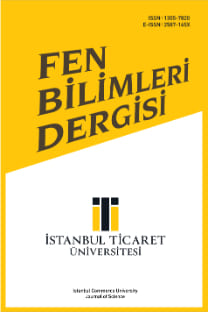OPTİMUM SIRALAMALI V-BLAST KULLANAN DİKGEN OLMAYAN ÇOKLU ERİŞİM
Dikgen olmayan çoklu erişimin (DOÇE), yaklaşmakta olan 6G standardının temel teknolojilerinden biri olması beklenmektedir. Bu, esas olarak DOÇE’nin tüm kullanıcıların aynı frekans bandını ve aynı zaman aralığını kullanmasını sağlama potansiyelinden kaynaklanmaktadır. Bu çalışmada, DOÇE çoklu girişli çoklu çıkışlı kablosuz iletişim sisteminde uygulanmaktadır. DOÇE’ye sıfıra-zorlamalı V-BLAST algoritması uygulanarak, spektral verimlilik arttırılmış ve ardışık girişim iptali gerçekleştirilmiştir. Optimum sıralama yapmak için, alıcı antenlerin imzaları karşılaştırılmış ve ilk önce hangi sinyalin çözüleceği belirlenmiştir. Optimum sıralama uygulanan sistem ile uygulanmayan sistemler kesinti olasılığı sonuçları açısından karşılaştırılmıştır. Bu sayede işaret-gürültü oranı açısından 3 dB'lik bir kazancın elde edildiği görülmektedir.
Anahtar Kelimeler:
Kablosuz haberleşme, dikgen olmayan çoklu erişim, çoklu giriş çoklu çıkış, V-BLAST, optimum sıralama
NON-ORTHOGONAL MULTIPLE ACCESS WITH V-BLAST UNDER OPTIMUM ORDERING
Non-orthogonal multiple access (NOMA) is expected to be one of the fundamental technologies of the upcoming 6G standard. This is mainly due to NOMA's potential in enabling all the users to utilize the same frequency band and the same time slot. In this paper, NOMA is implemented in a multiple-input multiple-output wireless communication system. By implementing zero-forcing V-BLAST algorithm into NOMA, spectral efficiency is improved, and successive interference cancellation is carried out. To perform optimum ordering, receive antennas’ signatures are compared and which signal to be decoded first is determined. Outage probability results of the system with optimum ordering and the same system without ordering are compared. In this way, a 3 dB gain is shown to be attained in terms of signal-to-noise ratio.
Keywords:
Wireless communications, non-orthogonal multiple access, multiple-input multiple-output, V-BLAST, optimum ordering,
___
- Ding, Z., Lei, X., Karagiannidis, G.K., Schober, R., Yuan, J. & Bhargava, V.K. (2017). A Survey on Non-Orthogonal Multiple Access for 5G Networks: Research Challenges and Future Trends. IEEE Journal on Selected Areas In Communications. 35(10), 2181-2195, https://doi.org/10.1109/JSAC.2017.2725519.
- Lan, Y., Benjebbour, A., Chen, X., Li, A. & Jiang, H. (2014, Dec. 15-17). Considerations on Downlink Non-Orthogonal Multiple Access (NOMA) Combined with Closed-loop SU-MIMO. 8th International Conference on Signal Processing and Communication Systems (ICSPCS). https://doi.org/10.1109/ICSPCS.2014.7021086.
- Rahman, T., Khan, F., Khan, I., Ullah, N., Althobaiti, M.M. & Alassery, F. (2021). NOMA and OMA-Based Massive MIMO and Clustering Algorithms for Beyond 5G IoT Networks. Wireless Communications and Mobile Computing. https://doi.org/10.1155/2021/6522089.
- NTT DOCOMO (2012). Requirements, Candidate Solutions & Technology Roadmap for LTE Rel-12 Onward. 3GPP RWS-120010.
- Bariah L., Mohjazi L., Muhaidat S., Sofotasisos P. C., Kurt G. K., Yanikomeroglu H. & Dobre O. A. (2020). A Prospective Look: Key Enabling Technologies, Applications and Open Research Topics in 6G Networks. IEEE Access. 8, 174792-174820, https://doi.org/10.48550/arXiv.2004.06049.
- Agiwal M., Roy A. & Saxena N. (2016). Next Generation 5G Wireless Networks: A Comprehensive Survey. IEEE Communications Surveys & Tutorials. 18 (3), 1617-1655, https://doi.org/10.1109/COMST.2016.2532458.
- Li, Q., Li, G., Lee, W., Lee, M., Mazzarese, D., Clerckx, B. & Li, Z. (2020). MIMO Techniques in WiMAX and LTE: A Feature Overview. IEEE Communications Magazine. 48(5) 86-92, https://doi.org/10.1109/MCOM.2010.5458368.
- Zheng, L. & Tse, D.N.C. (2003). Diversity and Multiplexing: A Fundamental Tradeoff in Multiple-Antenna Channels. IEEE Transactions on Information Theory. 49(5) 1073-1096, https://doi.org/10.1109/TIT.2003.810646.
- Saito, Y., Kishiyama, Y., Benjebbour, A., Nakamura, T., Li, A. & Higuchi K. (2-5 June 2013). Non-Orthogonal Multiple Access (NOMA) for Cellular Future Radio Access. IEEE 77th Vehicular Technology Conference (VTC Spring). Dresden, https://doi.org/10.1109/VTCSpring.2013.6692652.
- Mwakwata, C. B., Elgarhy, O., Alam, M. M., Moullec, Y. L., Parand, S., Trichias, K. & Ramantas K. (2021). Cooperative Scheduler to Enhance Massive Connectivity in 5G and Beyond by Minimizing Interference in OMA and NOMA. IEEE Systems Journal. 1-2, https://doi.org/10.1109/JSYST.2021.3114338.
- Liu, Y., Pan, G., Zhang, H. & Song M. (2016). On the Capacity Comparison Between MIMO-NOMA and MIMO-OMA. IEEE Access. 4, 2123-2129, https://doi.org/10.1109/ACCESS.2016.2563462.
- Ding, Z., Adachi, F. & Poor, H. V. (2016). The Application of MIMO to Non-Orthogonal Multiple Access. IEEE Transactions on Wireless Communications. 15(1), 537-552, https://doi.org/10.1109/TWC.2015.2475746.
- Özyurt, S. & Torlak, M. (2019). Exact Outage Probability Analysis of Dual-Transmit-Antenna V-BLAST With Optimum Ordering. IEEE Transactions on Vehicular Technology. 1(9), 977-982, https://doi.org/10.1109/TVT.2018.2880573.
- Timotheou, S. & Krikidis, I. (2015). Fairness for Non-Orthogonal Multiple Access in 5G Systems. IEEE Signal Processing Letters. 22(10), 1647-1651, https://doi.org/10.1109/LSP.2015.2417119.
- Loyka, S. & Gagnon, F. (2004). Performance Analysis of the V-BLAST Algorithm: An Analytical Approach. IEEE Transactions on Wireless Communications. 3(4), 1326-1337, https://doi.org/10.1109/TWC.2004.830853.
- Foschini, G. J. (1996). Layered Space-Time Architecture for Wireless Communication in a Fading Environment When Using Multi-Element Antennas. Bell Labs Technical Journal. 1(2), 41-59, https://doi.org/10.1002/bltj.2015.
- Foschini, G. J., Golden, G. D., Valenzuela, R. A. & Wolniansky, P. W. (1999). Detection Algorithm And Initial Laboratory Results Using V-BLAST Spacetime Communication Architecture. Electron. Lett. 35(1), 14-16, https://doi.org/10.1049/el:19990058.
- Kim, J. & Lee, I. (2005, Nov. 28). Coded Layered Space-Time Transmission with Signal Space Diversity in OFDM Systems. GLOBECOM ’05 IEEE Global Telecommunications Conference. St. Louis, https://doi.org/10.1109/GLOCOM.2005.1578494.
- Özyurt, S., Simon, E.P. & Farah, J. (2020). NOMA With Zero-Forcing V-BLAST. IEEE Communications Letters. 24(9), 2070-2074, https://doi.org/10.1109/LCOMM.2020.2997365.
- ISSN: 1305-7820
- Yayın Aralığı: Yılda 2 Sayı
- Başlangıç: 2002
- Yayıncı: Doç. Dr. Necip Şimşek
Sayıdaki Diğer Makaleler
PANDEMİ SÜRECİNDE ÇAĞRI MERKEZİ ÇALIŞANLARININ TÜKENMİŞLİĞİNE COVID-19 HASTALIĞININ ETKİSİ
Samet BABADAĞ, Özlem DENİZ BAŞAR
ULUSAL BİLGİ VE İLETİŞİM GÜVENLİĞİ REHBERİ: IoT GÜVENLİĞİ İÇİN BİR UYGULAMA ÖRNEĞİ
Muttalip TULGAR, Abdül Halim ZAİM, Muhammed Ali AYDIN
KİLİSE YAPILARININ DÖNÜŞÜMÜNÜN GAZİANTEP ÖRNEĞİ ÜZERİNDEN İNCELENMESİ
Gamze KABA, Seda BAĞDATLI KALKAN
PLANLANAN ÖZEL ETKİNLİK KATILIMCILARININ HARCAMA ANALİZİ: İKİLİ LOGİT MODELİ
Mahmut Esad ERGİN, Vail KARAKALE
BÜYÜK VERİDE ANONİMLEŞTİRME TEKNİKLERİ VE SALDIRI TÜRLERİ: UYGULAMA ÖRNEKLERİ
Hamza Talha GÜMÜŞ, Can EYÜPOĞLU
HAVAYOLU EKİP ROTASYON OPTİMİZASYONU İÇİN GENETİK ALGORİTMA KULLANIMI
